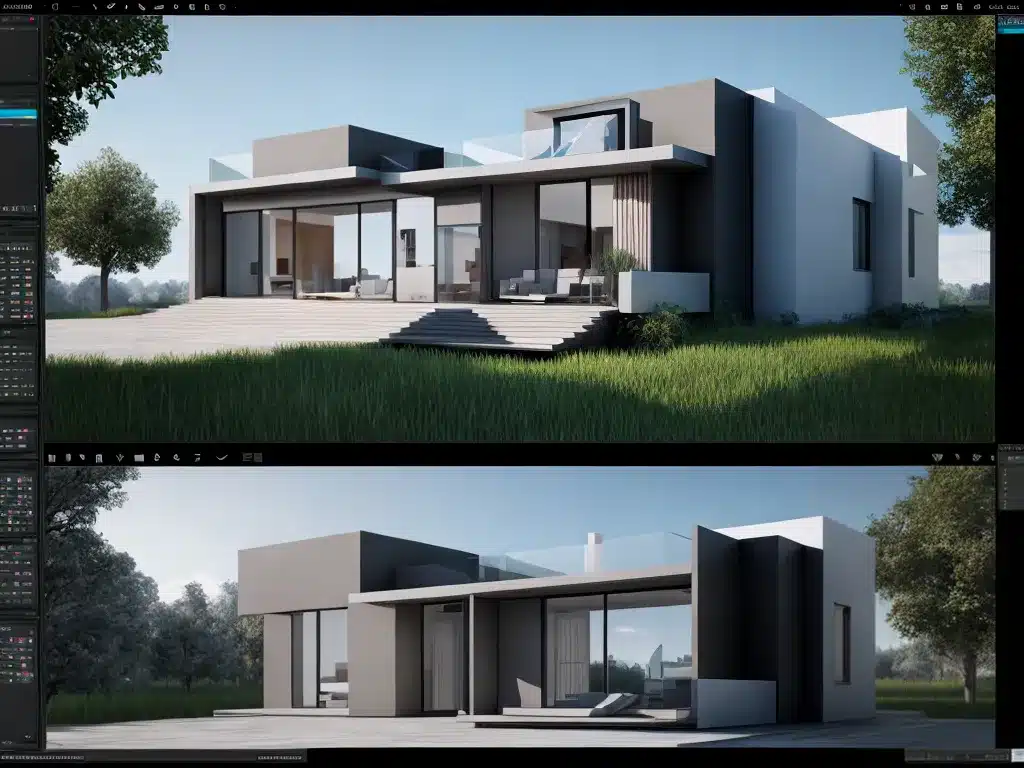
Introduction
As an architect or product designer, choosing the right 3D visualization tool is crucial for bringing your creations to life. The two most popular options are Unity and Unreal Engine. Both have strengths and weaknesses when it comes to architectural and product visualization. This article will compare the two game engines in depth, looking at rendering, assets, performance, learning curves, and other factors.
I have used both engines extensively for architectural visualization and product design projects. My goal is to provide an unbiased, comprehensive overview to help you decide which platform is best suited for your needs.
Rendering Capabilities
Graphics and Shaders
When it comes to rendering realistic materials and lighting, Unreal Engine has the edge over Unity. Unreal’s shaders and lighting systems like Lumen and Nanite create incredibly realistic graphics out of the box. The graphical quality you can achieve in Unreal for architectural visualization is remarkable.
Unity’s built-in render pipeline is decent, but you need to rely more on third-party assets and tweaking to achieve photorealism. With some work, Unity can produce nice architectural visuals, but Unreal sets the bar higher in terms of graphical fidelity.
Rendering Performance
Unreal Engine delivers better rendering performance, thanks to optimizations like the Temporal Super Resolution technique. On comparable hardware, Unreal renders scenes faster, especially larger and more complex ones with many light sources and geometric details.
Unity isn’t far behind, but you’ll experience more sluggish frame rates in complex scenes. The performance gap between the two has narrowed in recent years, but Unreal still has a noticeable edge.
Ray Tracing
For ultimate realism, ray tracing is a must-have. Both engines support ray tracing for lighting effects like reflections, shadows, ambient occlusion and global illumination.
Unity’s ray tracing implementation is good, but Unreal’s integration is more robust. Unreal offers higher ray counts, more effects covered by ray tracing, and overall better performance.
Assets and Content Creation
Asset Store vs Marketplace
Both platforms have large asset stores – the Unity Asset Store and Unreal Marketplace. For architectural visualization, Unreal’s Marketplace offers more robust options like complete furniture packs, high-quality 3D scans, and detailed materials.
The Unity Asset Store isn’t lacking, but many assets need additional tweaking to look right for architecture rendering. Unreal’s Marketplace makes it easier to quickly produce high-quality scenes.
3D Modeling Pipeline
When creating your own 3D assets, Unreal offers a more streamlined pipeline. Its native Datasmith integration allows importing CAD and BIM models faster and with less hassle. Unity is improving with solutions like CAD/BIM Link, but Unreal’s pipeline from modeling to visualization is more efficient.
Terrain and Organic Shapes
Unity has better tools for creating natural environments and organic shapes like terrain, plants, trees, and landscapes. Unreal can achieve similar results, but its terrain system is less artist-friendly. For architectural exteriors and placements, Unity provides a more customizable landscape creation workflow.
Ease of Use
Learning Curve
Unity is easier for beginners to pick up. Its scripting API uses C# which is familiar to many users. Unreal uses C++ which is more complex but offers deeper control. For non-coders doing architectural visualization, Unity’s simplicity gets you up and running faster.
Documentation and Community Support
Both platforms offer extensive official documentation and community forums. Unity has a slight edge here – its documentation is more focused on beginners, making it simpler to parse as a newcomer. Unreal’s documentation is extremely thorough but assumes more coding experience.
Architectural Visualization Features
Lighting
For realistic lighting and illumination, Unreal Engine is better suited for architecture. Global illumination, ray traced shadows and reflections, and sky lighting look more natural out of the box in Unreal. Unity can achieve similar results but requires more manual lighting tweaking.
Materials
Unreal provides more physically accurate architectural materials like concrete, wood, metal, etc that behave realistically under different lighting. Unity’s Standard Shader can simulate real-world materials too, but Unreal’s are higher quality.
Camera Effects
Unreal includes powerful post-processing to enhance realism like bloom, eye adaptation, and temporal anti-aliasing. Unity has similar effects available, but Unreal’s pipeline delivers them in a more accessible way.
Which is Better for Architectural Visualization?
For most architectural use cases, Unreal Engine edges out Unity. Unreal’s rendering capabilities produce incredibly realistic architectural visualizations with fewer compromises on lighting, materials, and environment fidelity.
However, for some specialized use cases like VR/AR architecture experiences, Unity’s cross-platform support and performance optimizations better suit those applications.
Unity isn’t far behind Unreal for architecture – with some asset enhancements and rendering tweaks it can achieve great visuals too. But for demanding applications like marketing visualizations for architecture firms, Unreal’s cutting-edge graphics simply can’t be matched by Unity currently.
Which is Better for Product Visualization?
For product design visualization, Unity gets the nod over Unreal. The ability to quickly iterate on materials, lighting, and product design concepts makes Unity better suited for this task. Unreal has superior rendering capabilities but its more complex workflows hamper fast product visualization.
Unity’s advantages for product viz include:
- Faster iteration and prototyping
- Simpler lighting tweaks and material editing
- More flexibility for camera rigs and angles to showcase products
- Wider device testing support for AR/VR product previews
Unreal produces higher fidelity visuals, but Unity’s workflow lends itself better to product design viz workflows. The quicker turnaround and cross-platform previews on Unity save time for product creators.
Conclusion
For architectural visualization, Unreal Engine 4 delivers unparalleled realism but has a steeper learning curve. For product visualization and design, Unity is faster and more iterative. Both platforms have strengths and weaknesses that suit different use cases.
Carefully weigh factors like rendering quality, performance, asset availability, ease of use, and cost. For architects and product designers, this comparison hopefully helps guide you to picking the game engine that best enables your visualization needs. Let me know if you have any other questions!












